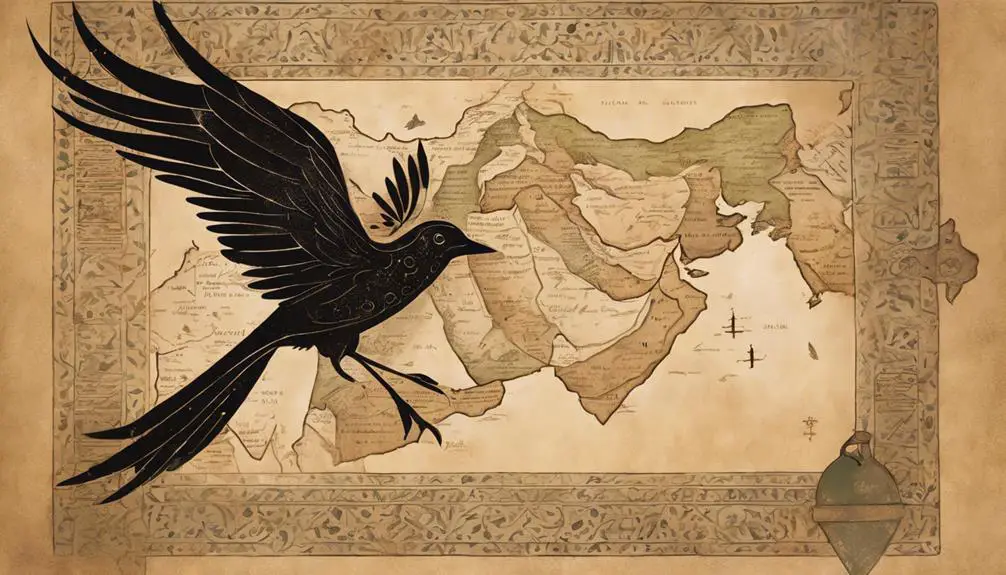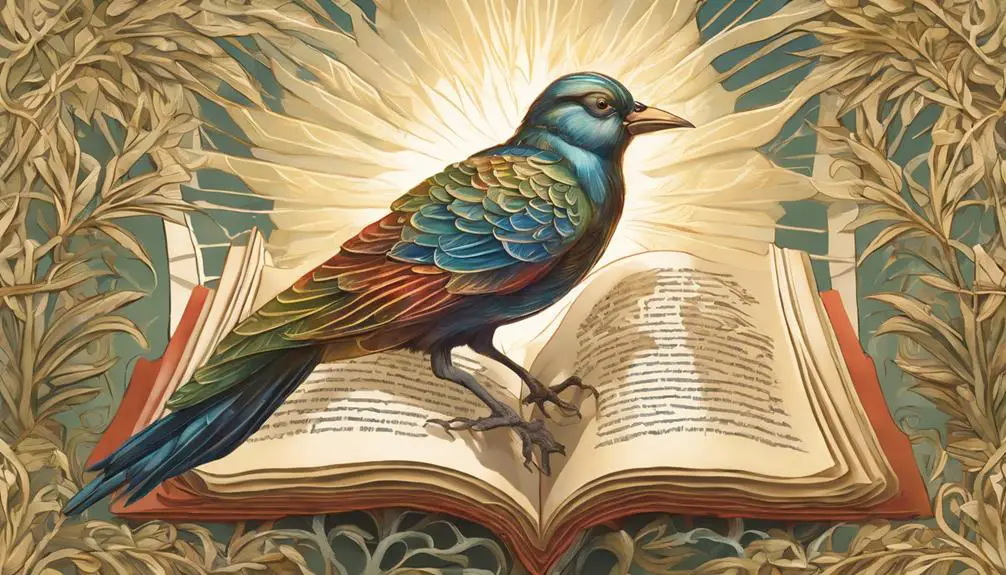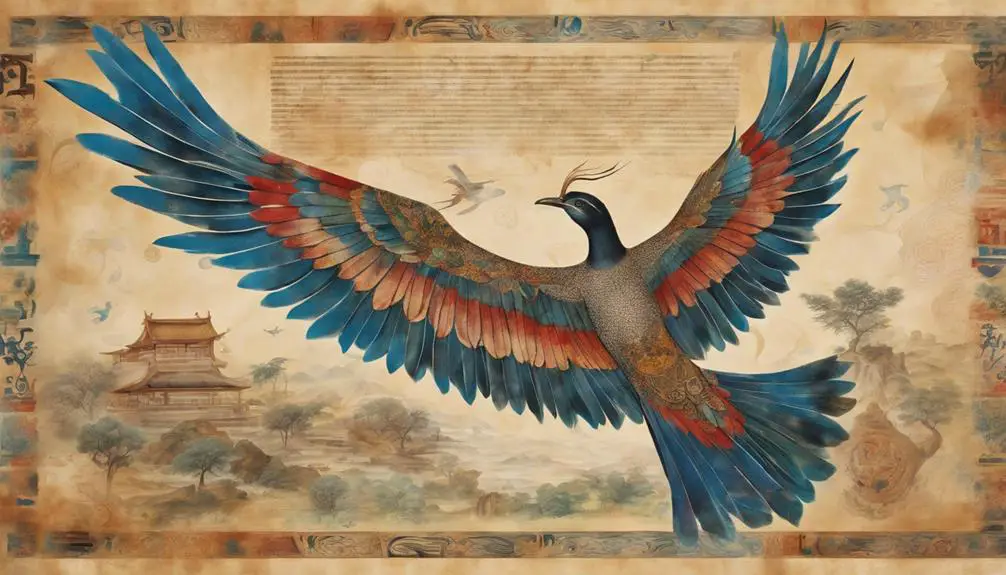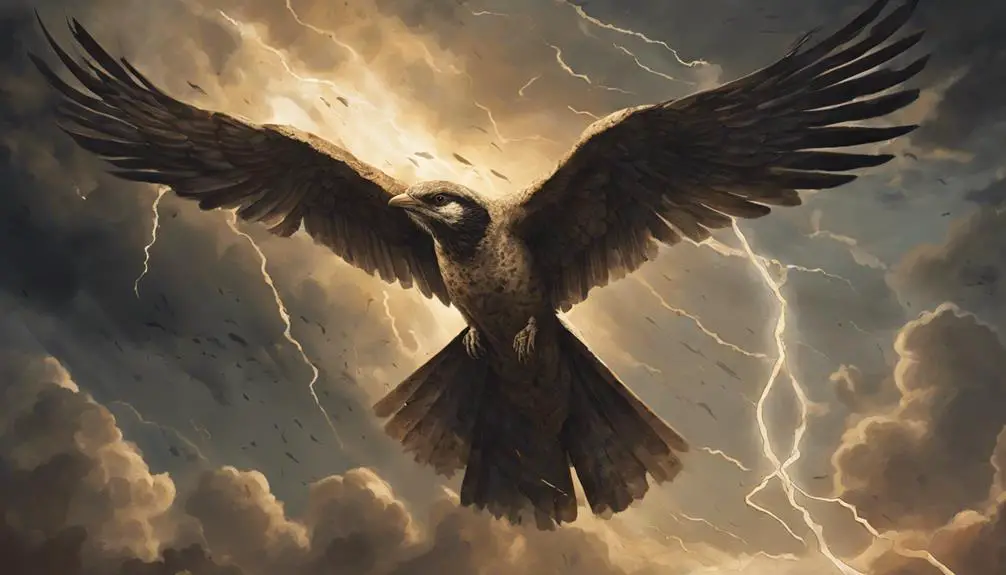Gain insight into 'The Great Speckled Bird,' a hymn entwined with biblical mystery and rich cultural debate, beckoning deeper exploration.

The Great Speckled Bird in the Bible
In 1936, Roy Acuff popularized 'The Great Speckled Bird,' a hymn that's intrigued many with its mysterious biblical origins. You've likely heard it in various contexts, perhaps without realizing its deep symbolic connections to scripture and its contentious interpretations over the years.
This song, while not directly mentioned in the Bible, draws from imagery that scholars and enthusiasts alike argue corresponds with specific passages. As you explore its rich history, you'll find yourself at the crossroads of faith, music, and controversy.
Unraveling its layers offers insights into not just a hymn but a phenomenon that has shaped cultural and religious discussions for decades.
Key Takeaways
- The hymn symbolizes divine protection and uniqueness, drawing from rich biblical imagery of birds representing light, purity, and redemption.
- Its controversial interpretations spark debates on its religious significance and cultural impact, reflecting diverse perspectives on faith and heritage.
- The hymn's symbolism encourages environmental stewardship, linking spiritual beliefs with the responsibility towards earth's biodiversity and sustainability.
- It serves as a reminder of the beauty in spiritual diversity, promoting dialogue and acceptance among varied religious communities.
Origins of the Hymn
The hymn 'The Great Speckled Bird,' rooted in biblical imagery, originated in the early 20th century, reflecting deep spiritual themes through its lyrics. Its musical evolution and authorship mystery have intrigued scholars and musicians alike, making it a fascinating subject of study.
You'll find that the hymn's journey from its inception to becoming a staple in American gospel music encapsulates a rich tapestry of cultural and theological exploration.
Delving into its origins, you encounter a landscape where oral traditions and unrecorded performances leave the hymn's exact birthdate and creator shrouded in mystery. This authorship mystery isn't merely a historical curiosity—it's a window into the fluid nature of folk music's transmission and adaptation across communities. The hymn's spread without clear attribution underscores the communal aspect of gospel music, where messages often outweighed the importance of individual recognition.
Moreover, the musical evolution of 'The Great Speckled Bird' reveals how it has been shaped and reshaped by various artists over the decades. Each rendition added layers to its identity, reflecting the changing landscapes of American religious and musical life. This evolution speaks to the hymn's ability to resonate across different eras, adapting to the spiritual and aesthetic needs of its listeners.
As you explore the origins of 'The Great Speckled Bird,' you're engaging with a piece of history that transcends the mere notes on a page. It's a journey through the complexities of authorship, the communal nature of song, and the ever-evolving landscape of American gospel music.
Biblical Connections

Delving into the biblical connections of 'The Great Speckled Bird,' we find a rich tapestry of imagery and themes that resonate deeply within the Christian tradition. This concept, while not explicitly named in the Bible, draws on ancient references and prophetic imagery that scholars and theologians have long debated and interpreted. To understand these connections, it's crucial to analyze the elements that contribute to the bird's symbolism in a biblical context.
- Ancient References: The Bible is replete with symbolic uses of birds, from the dove representing the Holy Spirit to the eagle symbolizing strength and renewal. These ancient references provide a backdrop against which 'The Great Speckled Bird' can be viewed, offering insights into how birds are used to convey divine messages and themes.
- Prophetic Imagery: Prophets in the Bible often used animals, including birds, to symbolize nations, peoples, and spiritual truths. This prophetic imagery helps to frame 'The Great Speckled Bird' within the broader context of biblical prophecy, suggesting a deeper, spiritual meaning behind the symbol.
- Symbolic Contrast: Throughout the Bible, the imagery of light and darkness, purity and impurity, is often portrayed through the symbolism of animals, including birds. 'The Great Speckled Bird,' with its distinctive appearance, can be seen as embodying this contrast, highlighting themes of grace amidst persecution or sanctity within a fallen world.
- Themes of Redemption and Judgment: Birds in the Bible sometimes symbolize divine intervention, judgment, or redemption. This connection suggests that 'The Great Speckled Bird' may represent themes of salvation and God's judgment, resonating with the Christian concept of being marked by God's grace yet facing the world's scorn.
Analyzing these biblical connections, it becomes clear that 'The Great Speckled Bird' is more than a mere avian reference; it's steeped in rich biblical symbolism, reflecting ancient references and prophetic imagery that continue to inspire and challenge believers.
Symbolic Interpretations

Exploring symbolic interpretations, you'll find that 'The Great Speckled Bird' embodies a complex array of meanings within the biblical narrative. This intriguing figure isn't merely a literal creature, but a rich source of religious symbolism, drawing your attention to the nuanced use of animal metaphors in scripture.
In the biblical context, animals often serve as symbols, conveying deeper spiritual truths. 'The Great Speckled Bird' is no exception, embodying themes of uniqueness, persecution, and divine protection. It's fascinating to see how this symbolic bird mirrors the experiences of the faithful who, despite being maligned or misunderstood by the world, are cherished and safeguarded by God.
Delving deeper, you'll recognize that the speckled appearance of the bird suggests a distinction from the norm, hinting at the idea of being set apart or chosen. This aligns with the biblical notion of God's people being distinct from the broader society, marked by their faith and moral convictions.
Moreover, the imagery of the bird, vulnerable yet protected, resonates with the theme of divine providence. It's a reminder that, in the face of adversity, believers aren't forsaken. This aspect of religious symbolism serves to encourage and fortify one's faith, suggesting that, like the bird, they're under the watchful eye of a higher power.
Cultural Impact

Throughout history, the symbolism of 'The Great Speckled Bird' has left a profound impact on various cultural expressions, influencing art, music, and literature. This iconic imagery has been interpreted and reinterpreted, shaping societal perceptions and inspiring a myriad of creative endeavors. The influence of this biblical symbol is both vast and nuanced, reflecting its enduring significance across different contexts and time periods.
In exploring its cultural impact, several key areas stand out:
- Musical Adaptations: Numerous songs and compositions have been inspired by 'The Great Speckled Bird,' spanning genres from gospel to country. These musical adaptations often explore themes of faith, betrayal, and redemption, resonating with listeners' personal experiences and societal values.
- Literary References: Writers have woven the symbol into narratives, poems, and essays, using it to add layers of meaning and complexity to their works. Through these references, the Great Speckled Bird becomes a multifaceted metaphor for human struggles, spiritual journeys, and the quest for identity.
- Artistic Representations: Artists have depicted the Great Speckled Bird in various mediums, from painting and sculpture to digital art. These representations often focus on the bird's unique beauty and its symbolic significance, inviting viewers to reflect on themes of diversity, resilience, and transcendence.
- Societal Perceptions: The symbol has influenced societal perceptions by embodying ideals of uniqueness and non-conformity. It challenges prevailing norms and encourages individuals to embrace their distinctiveness, fostering a sense of belonging and acceptance among those who feel marginalized or misunderstood.
Analyzing the cultural impact of 'The Great Speckled Bird' reveals its profound influence on artistic expression and societal perceptions, underscoring its timeless relevance and multifaceted nature.
Controversies and Debates

While the cultural impact of 'The Great Speckled Bird' has been profound and varied, it has also sparked significant controversies and debates, shaping discussions around its interpretation and representation. At the heart of these discussions are concerns regarding historical accuracy and theological implications, which you'll find are often intertwined.
Critics argue that interpretations of 'The Great Speckled Bird' sometimes lack historical accuracy, pointing out discrepancies between biblical texts and their modern interpretations. This debate isn't just academic; it affects how individuals and communities understand their religious heritage. You're looking at a scenario where the quest for historical veracity clashes with the desire for a narrative that resonates with contemporary faith practices.
Furthermore, the theological implications of 'The Great Speckled Bird' stir debate among scholars and believers alike. There's a tension between viewing the text as a metaphor for purity and diversity within the church, versus interpretations that might see it as symbolizing divisiveness or heresy. This dichotomy isn't trivial—it influences how communities of faith navigate issues of inclusion and exclusion, orthodoxy and heresy.
You're witnessing a dynamic where theological debates over 'The Great Speckled Bird' reflect broader discussions within Christianity about authority, interpretation, and identity. These controversies aren't just about deciphering an ancient text; they're about how that text informs contemporary beliefs and practices.
In essence, the debates surrounding 'The Great Speckled Bird' illustrate the complex interplay between historical scholarship and theological reflection. They challenge you to consider how ancient texts inform modern faith, pushing for a nuanced engagement with scripture that respects both its historical context and its living significance.
Modern Relevance

In today's rapidly changing world, the modern relevance of 'The Great Speckled Bird' continues to provoke thoughtful examination and debate among scholars and believers. This metaphor, rooted in biblical literature, extends its wings into contemporary discussions, shedding light on pressing issues and providing a unique lens through which to view them.
- Environmental Stewardship: The imagery of the speckled bird, often seen as a symbol of purity amidst contamination, resonates strongly with current environmental concerns. It encourages a reevaluation of humanity's relationship with nature, urging a shift towards more sustainable practices and a deeper respect for the earth's biodiversity.
- Spiritual Diversity: In a world where spiritual beliefs are as varied as the cultures they spring from, 'The Great Speckled Bird' serves as a reminder of the beauty and strength found in diversity. Its story, interpreted in multiple ways across different faiths, promotes a dialogue of understanding and acceptance among diverse spiritual communities.
- Moral and Ethical Reflection: The narrative surrounding 'The Great Speckled Bird' compels individuals to reflect on their moral and ethical standings, particularly in how they relate to themes of justice, integrity, and righteousness in contemporary society.
- Cultural Identity and Heritage: For many, the speckled bird symbolizes a connection to cultural roots and traditions. It stands as a testament to the endurance of heritage and identity in the face of globalization and homogenization, offering a source of pride and unity for communities.
Analyzing 'The Great Speckled Bird' through these lenses not only highlights its enduring relevance but also underscores its capacity to inspire and challenge today's society in meaningful ways.
Frequently Asked Questions
How Has the Great Speckled Bird Been Depicted in Various Forms of Artwork Throughout History?
You've likely seen the great speckled bird represented in various forms of artwork, where bird symbolism is richly explored. Artistic interpretations range from literal visual depictions to abstract expressions, capturing its essence across cultures and epochs.
These artworks delve into themes of identity, spirituality, and transformation, reflecting the bird's multifaceted symbolism. By examining these pieces, you gain insights into how artists have historically conceptualized and showcased this intriguing symbol.
Are There Any Specific Rituals or Practices in Different Cultures That Involve the Great Speckled Bird Symbol?
You'll find that various cultures embrace the symbolism of birds, including the great speckled bird, within their rituals and practices. These engagements often stem from cultural myths, where the bird's unique attributes are celebrated or invoked for spiritual and communal purposes.
Analyzing these practices reveals a rich tapestry of beliefs where the speckled bird plays a pivotal role, embodying themes of purity, transformation, or divine messages across different societies.
What Are the Psychological Implications or Interpretations of the Great Speckled Bird in Dreams or Subconscious Thought?
Dreaming of a great speckled bird might make you feel like you've stumbled into a strange nature documentary. This dream symbol holds significant meaning in the realm of dream analysis, delving into the depths of your psyche. Such a bird can symbolize themes of uniqueness or feeling under scrutiny. Its symbolic representation often mirrors your deepest contemplations about individuality or the fear of being judged.
Analytically, these dreams indicate a subconscious struggle with matters of identity and perception. They illuminate the internal conflicts and desires that you may be grappling with.
How Has the Concept of the Great Speckled Bird Influenced Fashion or Design Trends Over the Years?
You've seen how bird-themed weddings and avian-inspired jewelry have soared in popularity. This trend, deeply influenced by the concept of a unique and distinguished bird, mirrors a desire for individuality and connection with nature in fashion and design.
Designers have cleverly incorporated feather motifs and bird elements, creating a niche that appeals to those seeking symbolic meaning and elegance. This influence underscores a broader shift towards personalization and nature-inspired aesthetics.
Can the Great Speckled Bird Be Found in Any Notable Public Sculptures or Monuments Around the World?
You won't find the Great Speckled Bird perched in the annals of world-renowned public sculptures or monuments. This elusive avian phantom, despite its vivid imagery and rich symbolism, remains absent from the tangible realm of sculpture conservation.
When embarking on your birdwatching tips, don't expect to catch a glimpse of it in the stone or bronze. Its influence, while profound in literary and cultural discussions, hasn't crossed into the physical world of artistic homage.
Conclusion
In concluding, it's evident that 'The Great Speckled Bird,' originally rooted in biblical imagery, has transcended its religious confines to leave a lasting cultural mark. Symbolically rich, it has sparked diverse interpretations and debates, reflecting societal values and conflicts.
Its continued relevance and the controversies it ignites underscore a deeper search for identity and truth within collective narratives. Investigating its origins and symbolic meanings not only enriches our understanding but challenges us to ponder its implications in contemporary contexts.


Sign up